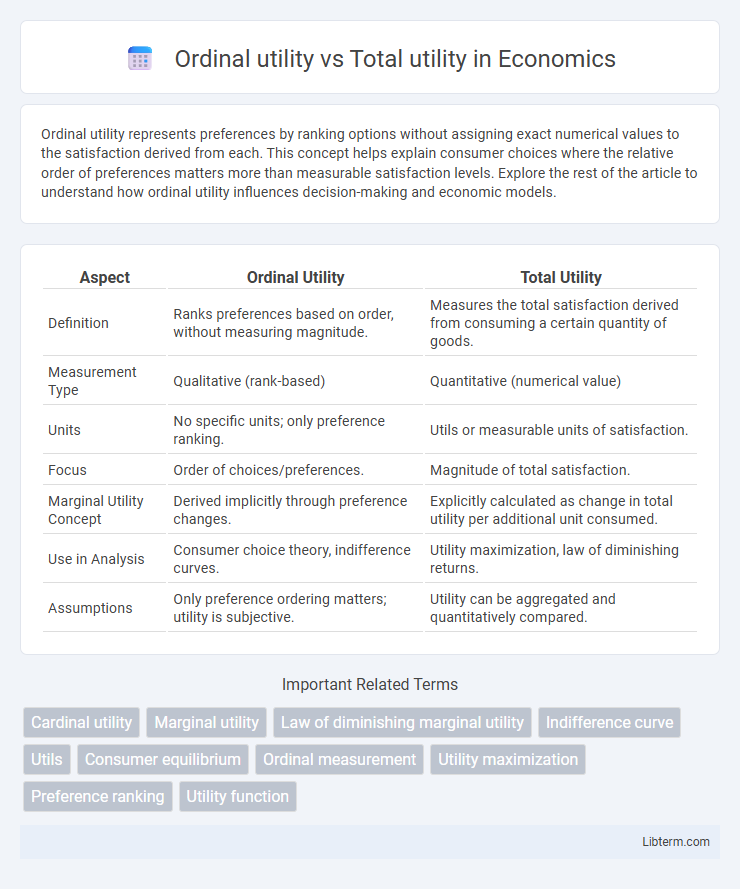Ordinal utility represents preferences by ranking options without assigning exact numerical values to the satisfaction derived from each. This concept helps explain consumer choices where the relative order of preferences matters more than measurable satisfaction levels. Explore the rest of the article to understand how ordinal utility influences decision-making and economic models.
Table of Comparison
| Aspect | Ordinal Utility | Total Utility |
|---|---|---|
| Definition | Ranks preferences based on order, without measuring magnitude. | Measures the total satisfaction derived from consuming a certain quantity of goods. |
| Measurement Type | Qualitative (rank-based) | Quantitative (numerical value) |
| Units | No specific units; only preference ranking. | Utils or measurable units of satisfaction. |
| Focus | Order of choices/preferences. | Magnitude of total satisfaction. |
| Marginal Utility Concept | Derived implicitly through preference changes. | Explicitly calculated as change in total utility per additional unit consumed. |
| Use in Analysis | Consumer choice theory, indifference curves. | Utility maximization, law of diminishing returns. |
| Assumptions | Only preference ordering matters; utility is subjective. | Utility can be aggregated and quantitatively compared. |
Introduction to Ordinal Utility and Total Utility
Ordinal utility measures consumer preferences by ranking goods in order of satisfaction without quantifying the exact level of utility, emphasizing comparative satisfaction rather than precise measurement. Total utility, in contrast, quantifies the overall satisfaction derived from consuming a specific quantity of goods or services, providing a numerical value to consumer happiness. The distinction highlights that ordinal utility focuses on preference order, while total utility emphasizes cumulative satisfaction levels.
Defining Ordinal Utility
Ordinal utility measures consumer preferences by ranking bundles of goods without assigning specific numerical values, reflecting the order of satisfaction rather than exact levels. It contrasts with total utility, which quantifies the exact amount of satisfaction derived from consuming goods. Ordinal utility is fundamental in consumer choice theory because it allows for preference comparisons based on order, aligning with the principle of rational choice without requiring measurable utility units.
Understanding Total Utility
Total utility measures the overall satisfaction or benefit a consumer derives from consuming a given quantity of goods or services, quantifying how much happiness or value is gained. It is an absolute measure expressed in utils or any consistent unit to represent consumer satisfaction, contrasting with ordinal utility, which ranks preferences without specifying magnitude. Understanding total utility helps analyze consumer behavior by emphasizing the cumulative gain and how consumption affects overall well-being.
Key Differences Between Ordinal and Total Utility
Ordinal utility ranks preferences based on the order of satisfaction without measuring the exact level of utility, while total utility quantifies the overall satisfaction derived from consuming a specific quantity of goods or services. Ordinal utility is qualitative, relying on preference comparisons such as "more preferred" or "less preferred," whereas total utility is quantitative, expressed in numerical values representing total satisfaction. The key difference lies in ordinal utility's inability to measure utility magnitude, contrasted with total utility's focus on the sum of satisfaction gained from consumption.
Measuring Utility: Ordinal vs Cardinal Approaches
Ordinal utility measures preferences by ranking options without assigning specific numerical values, emphasizing the order of choices rather than quantifying satisfaction. Total utility, associated with cardinal utility, assigns numerical values to the level of satisfaction derived from consuming goods, enabling precise measurement of changes in utility. Ordinal approaches prioritize preference patterns, while cardinal approaches provide a concrete scale for utility measurement, allowing for comparison of utility differences.
Implications for Consumer Choice Theory
Ordinal utility ranks consumer preferences without measuring satisfaction magnitude, influencing demand analysis through choice consistency rather than utility quantification. Total utility measures overall satisfaction from consuming goods, guiding consumer equilibrium by maximizing utility subject to budget constraints. Consumer choice theory relies on ordinal utility for preference ordering and total utility for understanding consumption levels and marginal utility impacts on decision-making.
Practical Examples in Economic Analysis
Ordinal utility measures consumer preferences by ranking options without specifying the magnitude of satisfaction differences, such as choosing between coffee and tea based on personal preference order. Total utility quantifies the overall satisfaction gained from consuming a certain quantity of goods, like deriving 50 utils from three cups of coffee. In economic analysis, ordinal utility helps understand consumer choice patterns while total utility aids in calculating marginal utility and demand curves.
Advantages and Limitations of Each Utility Concept
Ordinal utility offers the advantage of simplicity by ranking preferences without requiring exact numerical measurements, making it practical for analyzing consumer choice and demand where precise utility values are difficult to obtain. However, its limitation lies in the inability to measure the intensity of preferences or compare satisfaction levels across different goods. Total utility measures the overall satisfaction derived from consuming a certain quantity of goods, enabling quantitative analysis of consumer behavior and marginal utility, but it assumes cardinal measurement, which is often unrealistic and difficult to validate in real-world scenarios.
Impact on Demand Curve Analysis
Ordinal utility measures consumer preferences by ranking choices without quantifying satisfaction, influencing demand curve analysis by emphasizing relative utility comparisons. Total utility quantifies the overall satisfaction from consumption, allowing analysts to assess how changes in quantity affect consumer demand and the shape of the demand curve. Understanding both utility concepts is crucial for interpreting consumer behavior and predicting demand elasticity in economic models.
Conclusion: Choosing the Right Utility Concept
Choosing between ordinal utility and total utility depends on the context and purpose of the analysis; ordinal utility provides a rank-based preference framework suitable for subjective decisions without requiring specific numeric values. Total utility quantifies overall satisfaction from consuming goods, essential in measuring utility changes and economic behavior under cardinal assumptions. Applying the correct utility concept enhances economic modeling accuracy and better reflects consumer preferences in decision-making processes.
Ordinal utility Infographic

 libterm.com
libterm.com